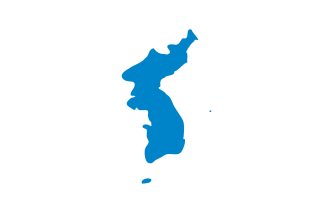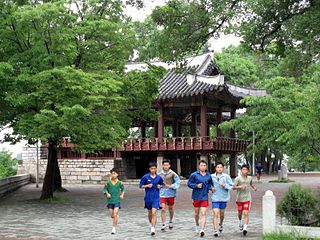
Korea is a peninsular region in East Asia. Since 1945, it has been divided at or near the 38th parallel, now known as the Korean Demilitarized Zone. In 1948, two states declared independence, both claiming sovereignty over all of Korea: South Korea comprising its southern half and North Korea comprising its northern half. The region consists of the Korean Peninsula, Jeju Island, and a number of minor islands near the peninsula. The peninsula is bordered by China (Manchuria) to the north and Russia to the northeast, across the Amnok and Duman rivers. It is separated from Japan to the southeast by the Korea Strait.

The Lower Paleolithic era on the Korean Peninsula and in Manchuria began roughly half a million years ago. The earliest known Korean pottery dates to around 8000 BC, and the Neolithic period began after 6000 BC, followed by the Bronze Age by 2000 BC, and the Iron Age around 700 BC. Similarly, according to The History of Korea, the Paleolithic people are not the direct ancestors of the present Korean people, but their direct ancestors are estimated to be the Neolithic People of about 2000 BC.

Goguryeo also later known as Goryeo, was a Korean kingdom located in the northern and central parts of the Korean Peninsula and the southern and central parts of modern day Northeast China. At its peak of power, Goguryeo controlled most of the Korean Peninsula, large parts of Manchuria and parts of eastern Mongolia and Inner Mongolia as well as Russia.

The Three Kingdoms of Korea or Samguk competed for hegemony over the Korean Peninsula during the ancient period of Korean history. During the Three Kingdoms period, many states and statelets consolidated until, after Buyeo was annexed in 494 and Gaya was annexed in 562, only three remained on the Korean Peninsula: Goguryeo, Baekje and Silla. The "Korean Three Kingdoms" contributed to what would become Korea; and the Goguryeo, Baekje and Silla peoples became the Korean people.
Gwanggaeto the Great was the nineteenth monarch of Goguryeo. His full posthumous name means "Entombed in Gukgangsang, Broad Expander of Domain, Peacemaker, Supreme King", sometimes abbreviated to Hotaewang. His era name is Yeongnak and he is occasionally recorded as Yeongnak Taewang. Gwanggaeto's imperial reign title meant that Goguryeo was on equal standing as an empire with the imperial dynasties in China.

Jangsu of Goguryeo was the 20th monarch of Goguryeo, the northernmost of the Three Kingdoms of Korea. He was born in 394 as the eldest son of Gwanggaeto. He became the crown prince in 408, and upon his father's death in 413, became the ruler at the age of 19.

Korea's military history spans thousands of years, beginning with the ancient nation of Gojoseon and continuing into the present day with the countries of North Korea and South Korea, and is notable for its many successful triumphs over invaders.
Munja of Goguryeo or Munjamyeong of Goguryeo was the 21st monarch of Goguryeo, the northernmost of the Three Kingdoms of Korea. He was the grandson of Taewang Jangsu (413–491). Though Munja's father Gochudaega Joda had been named Crown Prince by Taewang Jangsu, Joda died before assuming the throne. He is considered as a ruler of Goguryeo at its zenith from Gwanggaeto the Great.

This is a timeline of Korean history.

King Gogugwon of Goguryeo was the 16th king of Goguryeo, the northernmost of the Three Kingdoms of Korea. He was the son of King Micheon and Lady Ju.

Gungnae or Guonei was the capital of the ancient Korean kingdom of Goguryeo, which was located in Manchuria and the Korean Peninsula. The perimeter of its outer fortress measures 2,686m. It is located in present day Ji'an city, Jilin province, northeast China. Because of its historical importance and exceptional architecture, Gungnae was designated as a UNESCO World Heritage Site in 2004. It is part of the Capital Cities and Tombs of the Ancient Koguryo Kingdom World Heritage Site, together with nearby Hwando Mountain City and the Onyeosan City, in modern northeast China.

The Battle of Salsu was a major battle that occurred in the year 612 during the second campaign of the Goguryeo–Sui War between Goguryeo of Korea and Sui of China. Goguryeo won an overwhelming victory over the numerically superior Sui forces at Salsu River.

The military history of Goguryeo involves wars with other Korean kingdoms, Chinese dynasties, nomadic states and tribes, and Wa Japan. Goguryeo was a highly militaristic state; it was a powerful empire and one of the great powers in East Asia, until it was defeated by a Silla–Tang alliance in 668 after prolonged exhaustion and internal strife caused by the death of Yeon Gaesomun.
The Goguryeo controversies are disputes between China and Korea on the history of Goguryeo, an ancient kingdom located in present-day Northeast China and the Korean Peninsula. At the heart of the Goguryeo controversy is which part of history the kingdom belongs to. Korean scholars have the viewpoint that Goguryeo is part of Korean history alone.

The Goguryeo–Tang War occurred from 645 to 668 and was fought between Goguryeo and the Tang dynasty. During the course of the war, the two sides allied with various other states. Goguryeo successfully repulsed the invading Tang armies during the first Tang invasions of 645–648. After conquering Baekje in 660, Tang and Silla armies invaded Goguryeo from the north and south in 661, but were forced to withdraw in 662. In 666, Yeon Gaesomun died and Goguryeo became plagued by violent dissension, numerous defections, and widespread demoralization. The Tang–Silla alliance mounted a fresh invasion in the following year, aided by the defector Yeon Namsaeng. In late 668, exhausted from numerous military attacks and suffering from internal political chaos, Goguryeo and the remnants of Baekje army succumbed to the numerically superior armies of the Tang dynasty and Silla.

The Tomb of King Dongmyeong, also known as the Tomb of King Tongmyŏng, is a mausoleum located in near Ryongsan Village, Ryokpo-guyok, Pyongyang, North Korea. One of the tombs is the royal tomb of Jumong, the founder of the ancient Goguryeo Kingdom, the northernmost of the Three Kingdoms of Korea. King Jumong was given the posthumous name of King Dongmyeong. In total, there are 63 individual tombs of the period. The area around Dongmyeong's grave contains at least fifteen known tombs believed to belong to various vassal lords. The tomb has achieved World Heritage status as part of the Complex of Goguryeo Tombs inscribed by UNESCO in 2004 under Criteria (i), (ii), (iii) and (iv) covering an area of 233 hectares with a buffer zone of 1,701 hectares. A unique feature of it and the other extant tombs in the area are the wall paintings depicting blossoming lotuses, indicative of Buddhism practiced and perhaps prevalent in Korea around 277 BC to 668 AD.

Ryongwang Pavilion is a scenic overlook located in the central district of Pyongyang, North Korea. Located on the bank of the Taedong River, the pavilion was first constructed during the Goguryeo dynasty as "Sansu Pavilion", and was part of the defenses of the walled city of Pyongyang. It is labeled as National Treasure #16 in North Korea.

The history of Sino-Korean relations dates back to prehistoric times.
The Anhak Palace (Korean: 안학궁) was the royal residence of the Goguryeo Kingdom after the capital was moved to Pyongyang from Gungnae. Originally built in 427 AD, the palace is located in the Taesong District of Pyongyang, North Korea, at the foot of Mount Taesong.
Imperial titles were used in various historical Korean states before the 14th century and at the turn of the 20th century: Early Korean states used "great king", "greatest king", and "holy king"; later Korean states used "emperor". Korean monarchs who used imperial titles had political and religious authority over a realm or domain. The Chinese concept of tianxia, pronounced "cheonha" in Korean, was variously adopted and adapted to Korean views of the world from period to period.











